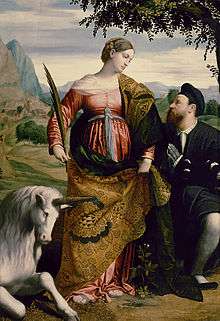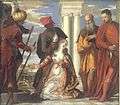Justina of Padua
| Saint Justina of Padua | |
|---|---|
|
Saint Justina by Bartolomeo Montagna | |
| Martyr | |
| Died | ~ 304 AD |
| Venerated in | Roman Catholic Church |
| Major shrine | Church of Saint Anthony of Lisbon |
| Feast | October 7 |
| Attributes | young woman setting a cross on the head of the devil while holding a lily in her hand; young woman with a crown, palm, and sword; young woman with a palm, book, and a sword in her breast; young woman with a unicorn, symbolizing virginity, and palm; young woman with Saint Prosdocimus |
| Patronage | Padua; Palmanova |
Justina of Padua (Italian: Santa Giustina di Padova) is a Christian saint and a patroness of Padua. She is often confused with Justina of Antioch.
Legend
St. Justina of Padua (October 7) was a virgin of royal birth in the city which claims her patronage. She is represented in Christian Art crowned as a princess, and with a sword transfixing her bosom, in accordance with her martyrdom, AD. 303.[1]
In the 6th century the Paduans dedicated a church to her and she was among the virgin martyrs portrayed in the presbytery arch in the Euphrasian Basilica (at left) and in the procession of virgins in Sant'Apollinare Nuovo. In the 7th century, Venantius Fortunatus, writing in Gaul, urged travelers to Padua to visit her relics there.[2]
Medieval histories describe her as a disciple of Saint Peter the Apostle. Thus, Saint Prosdocimus, the first bishop of Padua, is said to have been Justina's spiritual father; his histories state that he was sent from Antioch by Peter. This however is physically impossible as Justina being a young woman in 304 AD could not have known Prosdocimus as he died in approximately 100 AD.
Veneration
St. Justina is a patron saint of Padua. After St. Mark, she is also a second patroness of Venice.[3] Her feast day is October 7 and coincided with the end of grape harvest and the time for settling agricultural contracts.[4]
The Paduan Basilica and Abbey of Santa Giustina houses the Martyrdom of St. Justine by Paolo Veronese. The Abbey complex was founded in the 5th century on Justine's tomb, and in the 15th century became one of the most important monasteries in the area, until it was suppressed by Napoleon in 1810. In 1919 it was reopened. The tombs of several saints are housed in the interior, including those of Justina, Prosdocimus, St. Maximus, St. Urius, St. Felicitas, St. Julian, as well as relics of the Apostle St. Matthias and the Evangelist St. Luke.
Gallery
-

Justina of Padua by Mantegna
-

Saint Justina with the Unicorn, circa 1530, by Moretto da Brescia
-

Paolo Veronese, The Martyrdom of St. Justine
See also
References
- ↑ Wagner, Leopold. "Patron Saints and Their Atributes", Manners, Customs, and Observances, London, William Heineman, 1894
- ↑ Stracke, Richard. "Saints Justina & Prodoscimus of Padua and Saints Justina & Cyprian of Antioch", ChristianIconography.info, University of Augusta
- ↑ Butler, Alban. "St. Justina of Padua, Virgin and Martyr", The Lives of the Saints. vol.X, 1866
- ↑ Knapton, Michael, Law, John E., Smith, Alison. Venice and the Veneto during the Renaissance, Firenze University Press, 2014 ISBN 9788866556633
| Wikimedia Commons has media related to Justina of Padua. |
